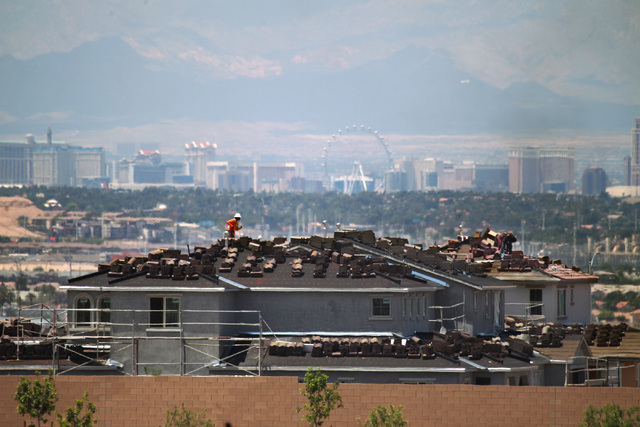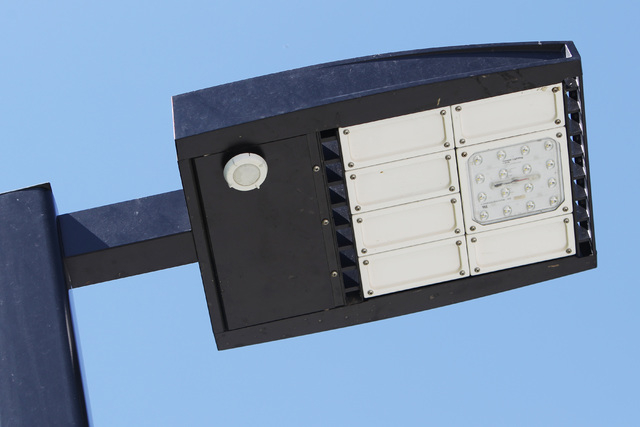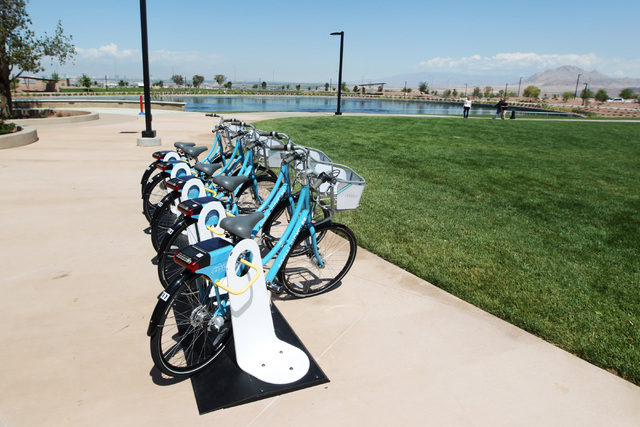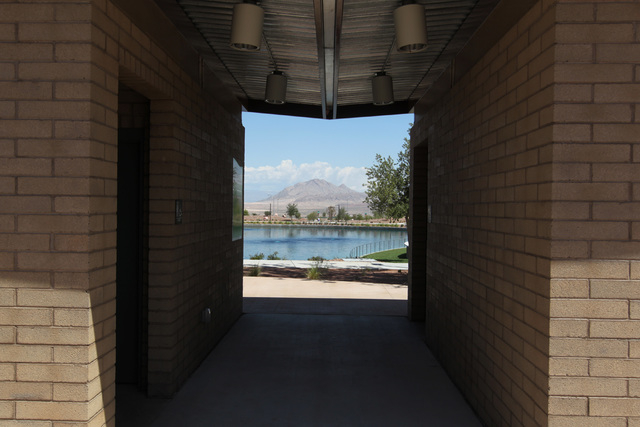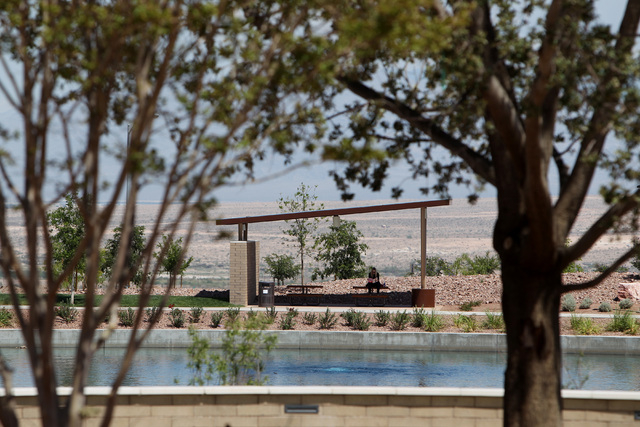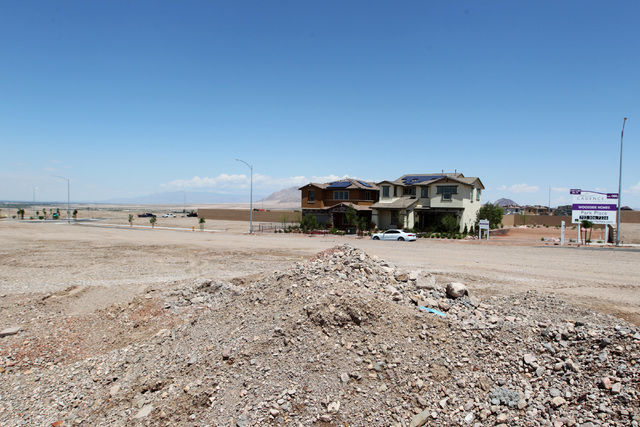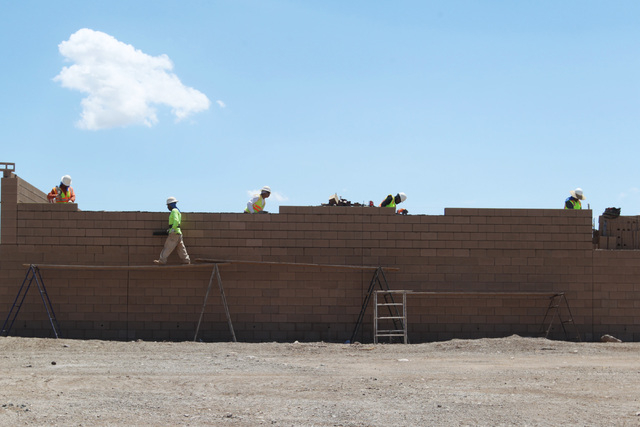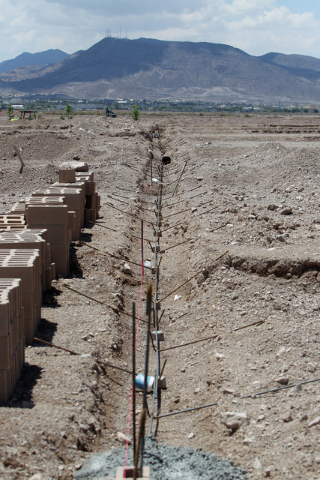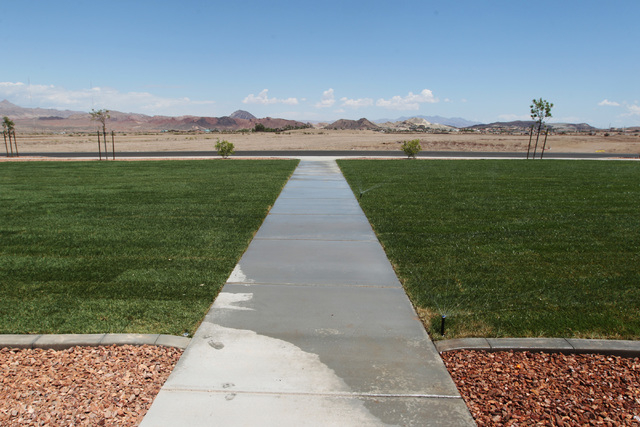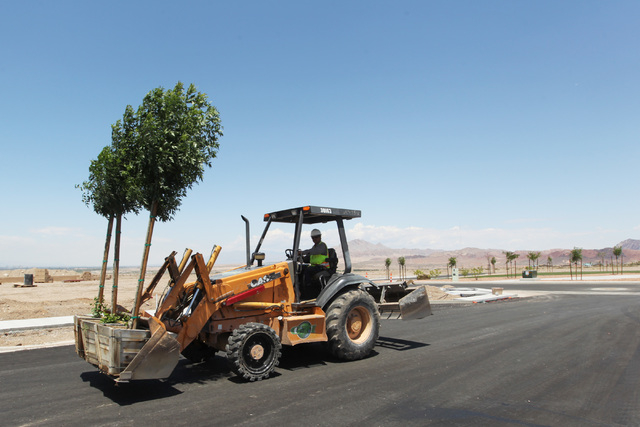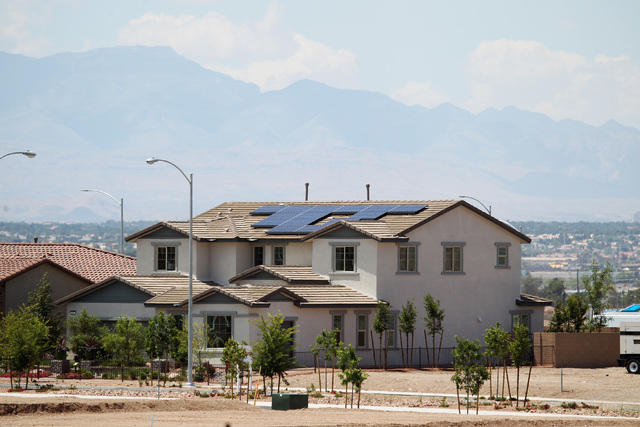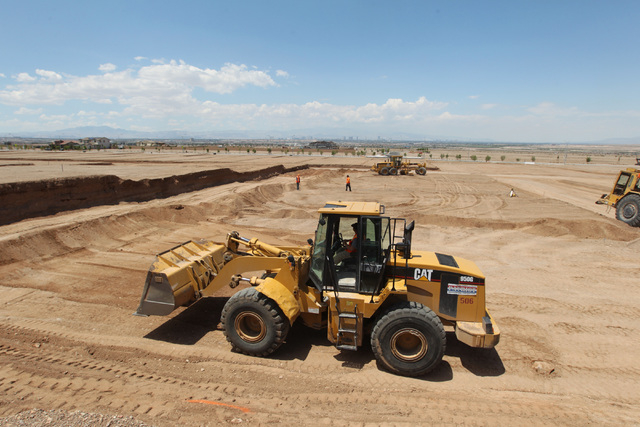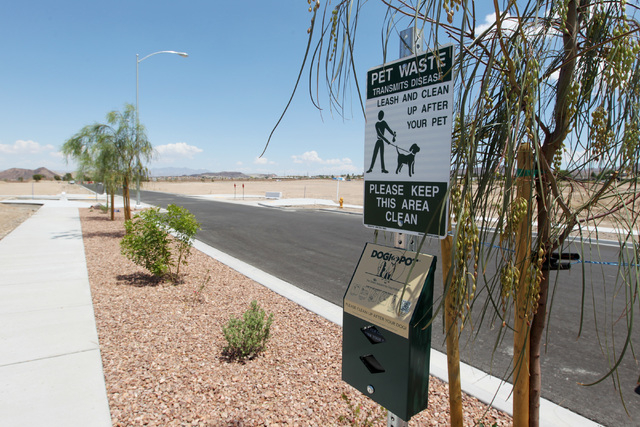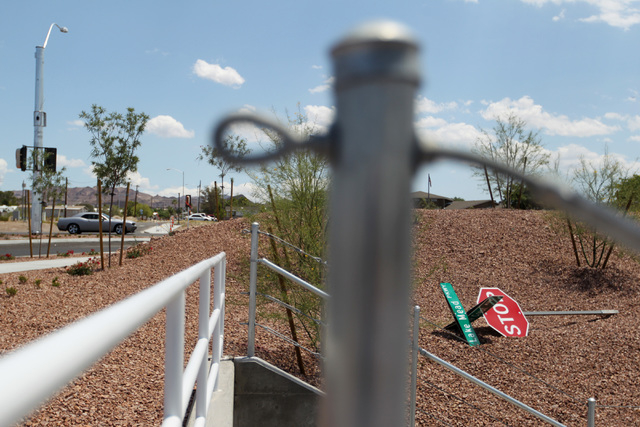Cadence begins slow march from Henderson’s industrial shadow
Near the entrance to Henderson’s newest master-planned community, an 11-acre expanse of grass, mature trees and curved walking paths slopes down toward the signature feature: a two-acre pond reflecting a panoramic view of the distant Strip.
Call it a touch of unintended irony for property once covered with ponds of a different sort.
For decades, large portions of the 2,200-acre tract now known as Cadence housed evaporation ponds used by the nearby manufacturing plants that gave Henderson its start. The first ponds were dug in the 1940s to support wartime magnesium production. Starting in the early 1950s, the site held wastewater from the production of titanium, chlorine, pesticides and rocket fuel.
Manufacturers stopped dumping their waste into the unlined ponds in 1976. All industrial activity at the Cadence site ceased in 2005.
Extensive surveys of the land north of Boulder Highway and Lake Mead Parkway turned up a host of contaminants, including metals, radioactive isotopes, pesticides, asbestos and perchlorate. The late Hal Rothman, an esteemed UNLV history professor and member of Clark County’s Growth Task Force, once called it “the most polluted place in the Las Vegas Valley.”
What followed was the largest soil cleanup in Nevada history — a $135 million effort, all paid for with private money, that removed 3.5 million cubic yards of contaminated earth.
“We’ve spent a lot of money and a lot of time to make it right,” said Lee Farris, who helped lead the cleanup and create the master plan for Cadence as a vice president of the LandWell Company, the developer of the project. “We literally walked every square inch of the property.”
The work was supervised by the Nevada Department of Environmental Protection, which gradually cleared the land for development in phases. Farris said he expects the state to sign off on the last of it — two pieces totaling about 210 acres — in June.
That sounds about right to JoAnn Kittrell, spokeswoman for the state’s environmental regulatory agency.
“NDEP has determined that all soils in that area meet residential standards,” she said. “From NDEP’s perspective, they’ve gone above and beyond. It’s just wonderful that this land has been reclaimed. It’s such a success story.”
MARKETING CHALLENGE
In some ways, cleaning up the site might have been the easy part. Now Cadence and its homebuilding partners face the marketing challenge of trying to convince home buyers they’re getting something quite the opposite of an industrial site: a walkable, health-oriented, eco-friendly community with ample parks and open spaces.
The green area with the pond at the heart of Cadence is called Central Park, and its next phase will add 40 acres of grass and trees, all irrigated with reclaimed water pumped in from a nearby Henderson treatment plant and stored in that signature water feature.
“It’s essentially an irrigation pond,” Farris said. “It was a unique opportunity (to use reclaimed water), and we really wanted to incorporate it any way we could.”
The $2 million investment won’t provide reclaimed water throughout Cadence, but the core around Central Park will be kept green without using tap water.
Other environmentally conscious amenities include rooftop solar panels offered as an upgrade by the community’s homebuilders and motion-sensing LED lights along the sidewalks that glow at about 30 percent of full power most of the time but brighten when someone is within about 20 feet.
Instead of thirsty palms, the list of approved landscaping for the development includes “trees that do well in the desert but don’t use a lot of water,” Farris said.
Cadence even has launched a bike-share program, with 20 bicycles and 30 bike racks scattered around the community for people to use free of charge with an online registration.
So far, the results of the green-tinged pitch have been mixed.
According to local housing analysis firm Home Builders Research, just nine homes have been sold at Cadence since sales began in December despite above-average traffic through the development’s dozen or so model homes. That is a far slower sales rate than other valley developments, but it’s unclear what — if anything — the site’s industrial past might have to do with that.
The slow start could be a function of what the housing companies decided to build first at Cadence, where much of what is being offered so far trends toward larger multistory homes with tiny backyards priced at $325,000 and up.
Local real estate marketing expert Ron Rulof said potential customers probably have more pressing concerns — things such as the layout and pricing of the homes now available, the quality of nearby schools and the development’s proximity to retail and other services — than what chemicals might have been dug up and removed.
“I think in the consumer’s mind, that’s been negated to an extent,” said Rulof, a longtime consultant to some of the valley’s largest builders and developers.
YESTERDAY AND TODAY
It’s unclear how many potential buyers are even aware of what came before Cadence.
The developer doesn’t exactly advertise its reclamation work — unless you count slogans like “Where yesterday meets today” — but they’re not trying to bury the information in a landfill somewhere, either.
Cadence spokeswoman Cheryl Persinger said the company recently produced a brochure for builders and potential buyers explaining the past use and the restoration effort. Some of that information is also mentioned in passing on the development’s website, cadencenv.com, and provided in far greater detail at brcrestorationproject.com, a site set up by Basic Remediation Company, a firm established for the cleanup by LandWell’s parent company.
Farris said any piece of discolored soil they saw, no matter how small, was hauled away. In many cases they didn’t even wait for test results showing the need for disposal.
“It didn’t matter. If it didn’t look right, we’d take it,” he said.
In some places, they had to dig down 6 inches or so; in others, it was several feet. Excavated soil was trucked to a landfill in Henderson that since has been sealed and closed, Farris said.
Since the remediation work was finished, he said, roughly 300 soil samples taken from the property show “we’ve had no issues.”
For extra reassurance, every residential lot sold in Cadence will undergo one last round of soil testing before construction starts, and every homeowner will receive a certificate stating that the land meets safe residential standards with no further action needed.
Persinger said Cadence probably will take 15 to 20 years to build out completely, with 13,250 homes and 1.1 million square-feet of commercial space, including a 1,500-room casino-resort. But no one lives there yet. Persinger said the first residents are scheduled to move in this August.
They eventually will be joined by several people who took part in the cleanup and development of Cadence.
The project’s construction manager already has put a down payment on a lot, and Farris said he plans to live there, too, though he is not sure exactly where in the community he and his family will end up.
“I don’t get to make decisions like that in my household,” he said.
Review-Journal writer Jennifer Robison contributed to this report. Contact Henry Brean at hbrean@reviewjournal.com or 702-383-0350. Find him on Twitter @RefriedBrean.
Parks, schools, homes on way to Henderson’s Cadence community
Cadence, under the radar for 2 years, ready for sales push
Growing Henderson family becomes first buyer at Cadence



